Research Report: Analysis of Software Project Risk in MITS5501 Course
VerifiedAdded on 2022/11/25
|9
|2272
|446
Report
AI Summary
This report analyzes the journal paper "Research and Analysis on Software Project Risk Based on Bibliometrics" by Ying Qu and Moran Fan, focusing on software project risk management. The report begins with an introduction that identifies the paper and outlines the purpose of the report. The body of the report describes the intention and content of the original article, its research methods (qualitative design, literature review, secondary data collection, and descriptive content analysis), and its findings. The paper emphasizes that understanding project risks is critical for software project success, and the lack of risk assessment increases security threats. The report highlights issues emphasized by the authors such as the difficulty of controlling risks and the impact of factors like complexity and long project cycles. The research uses bibliometrics to identify and analyze the risks associated with software projects. The report concludes by discussing the relevance of the paper's conclusions, which underscore the importance of risk assessment in the software development life cycle and suggests that risk assessment is an effective approach to controlling and managing software project risks. The report is written to fulfill the requirements of a MITS5501 assignment, providing a critique and analysis of the original research paper.
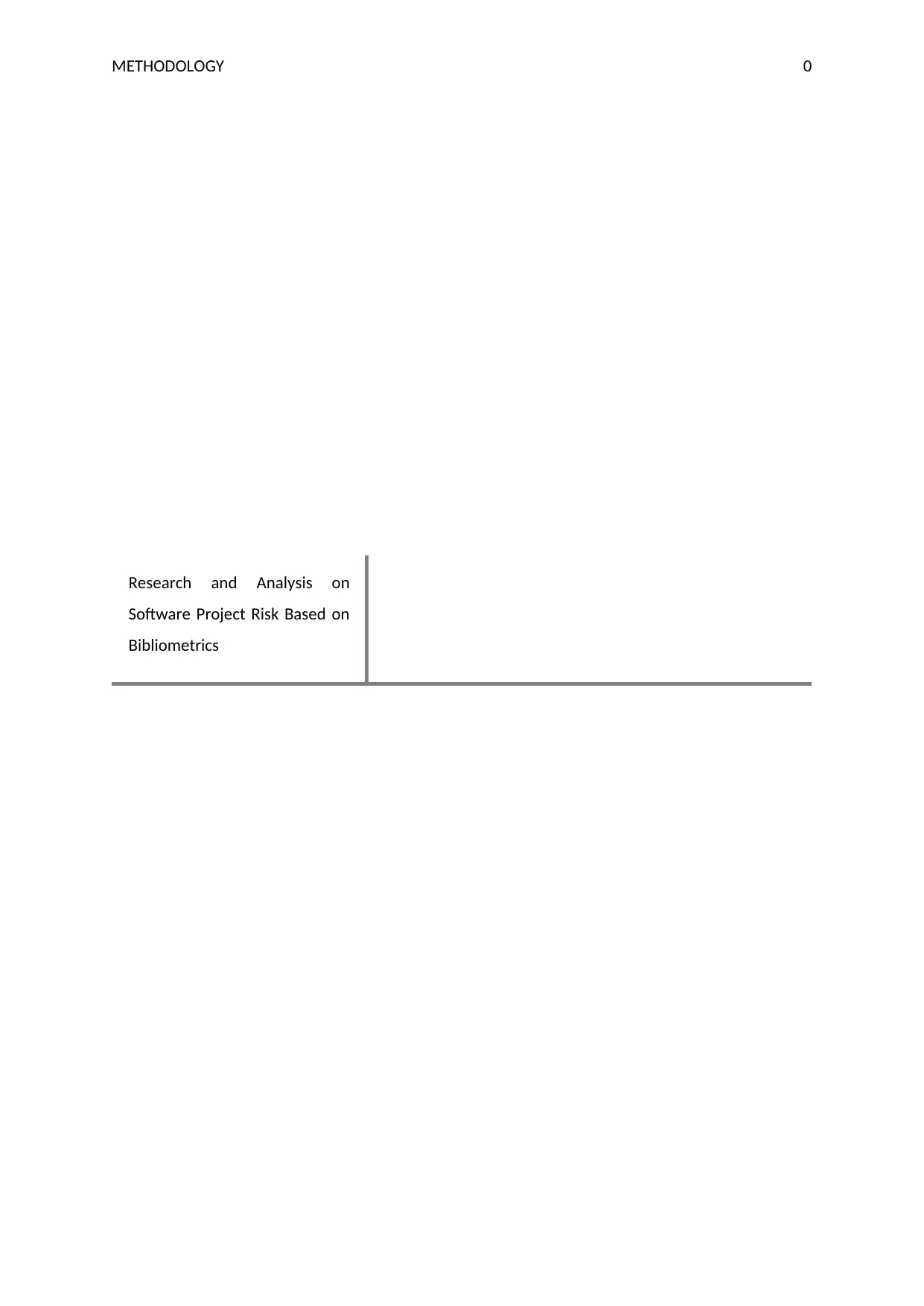
METHODOLOGY 0
Research and Analysis on
Software Project Risk Based on
Bibliometrics
Research and Analysis on
Software Project Risk Based on
Bibliometrics
Paraphrase This Document
Need a fresh take? Get an instant paraphrase of this document with our AI Paraphraser
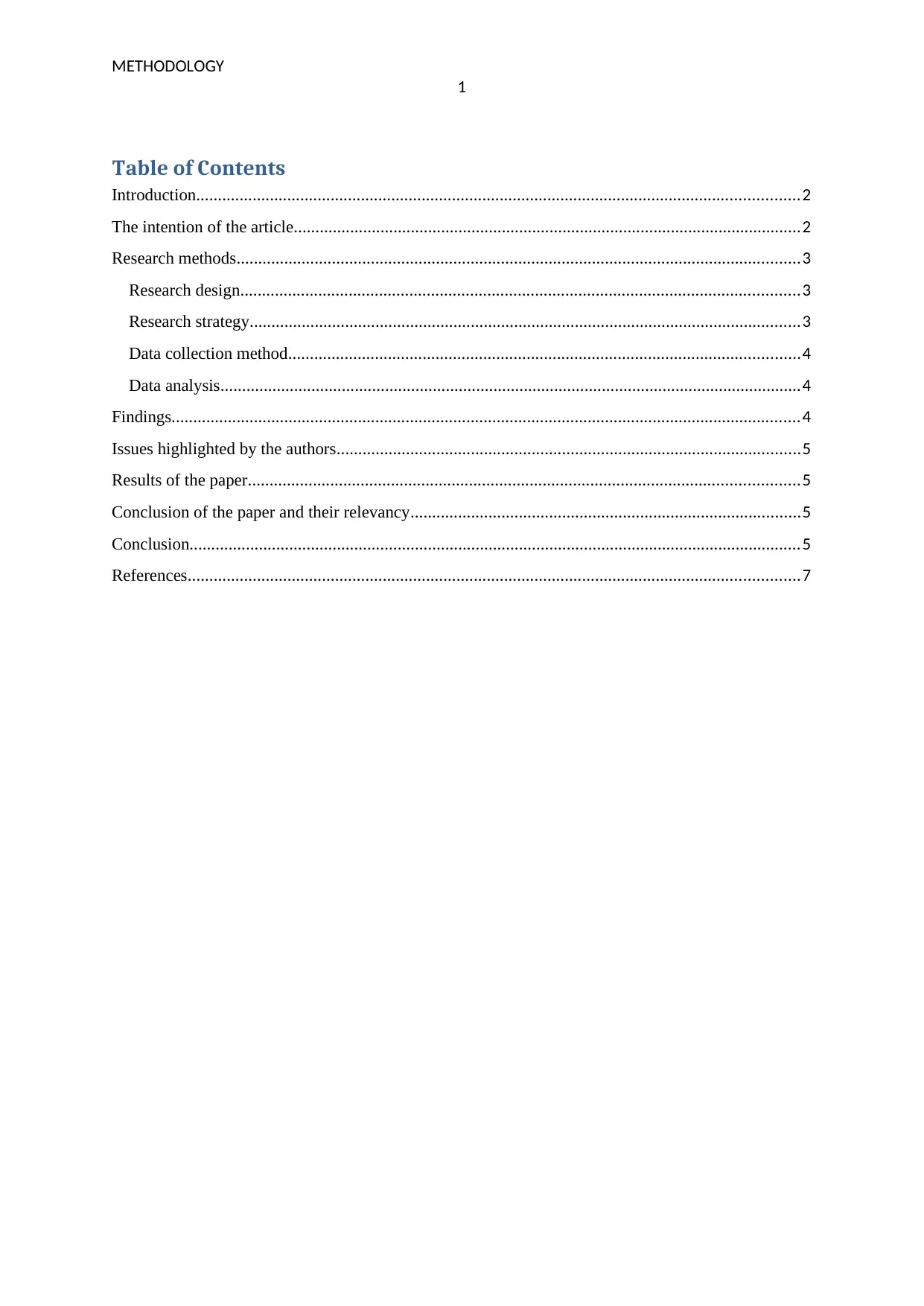
METHODOLOGY
1
Table of Contents
Introduction...........................................................................................................................................2
The intention of the article.....................................................................................................................2
Research methods..................................................................................................................................3
Research design.................................................................................................................................3
Research strategy...............................................................................................................................3
Data collection method......................................................................................................................4
Data analysis......................................................................................................................................4
Findings.................................................................................................................................................4
Issues highlighted by the authors...........................................................................................................5
Results of the paper...............................................................................................................................5
Conclusion of the paper and their relevancy..........................................................................................5
Conclusion.............................................................................................................................................5
References.............................................................................................................................................7
1
Table of Contents
Introduction...........................................................................................................................................2
The intention of the article.....................................................................................................................2
Research methods..................................................................................................................................3
Research design.................................................................................................................................3
Research strategy...............................................................................................................................3
Data collection method......................................................................................................................4
Data analysis......................................................................................................................................4
Findings.................................................................................................................................................4
Issues highlighted by the authors...........................................................................................................5
Results of the paper...............................................................................................................................5
Conclusion of the paper and their relevancy..........................................................................................5
Conclusion.............................................................................................................................................5
References.............................................................................................................................................7
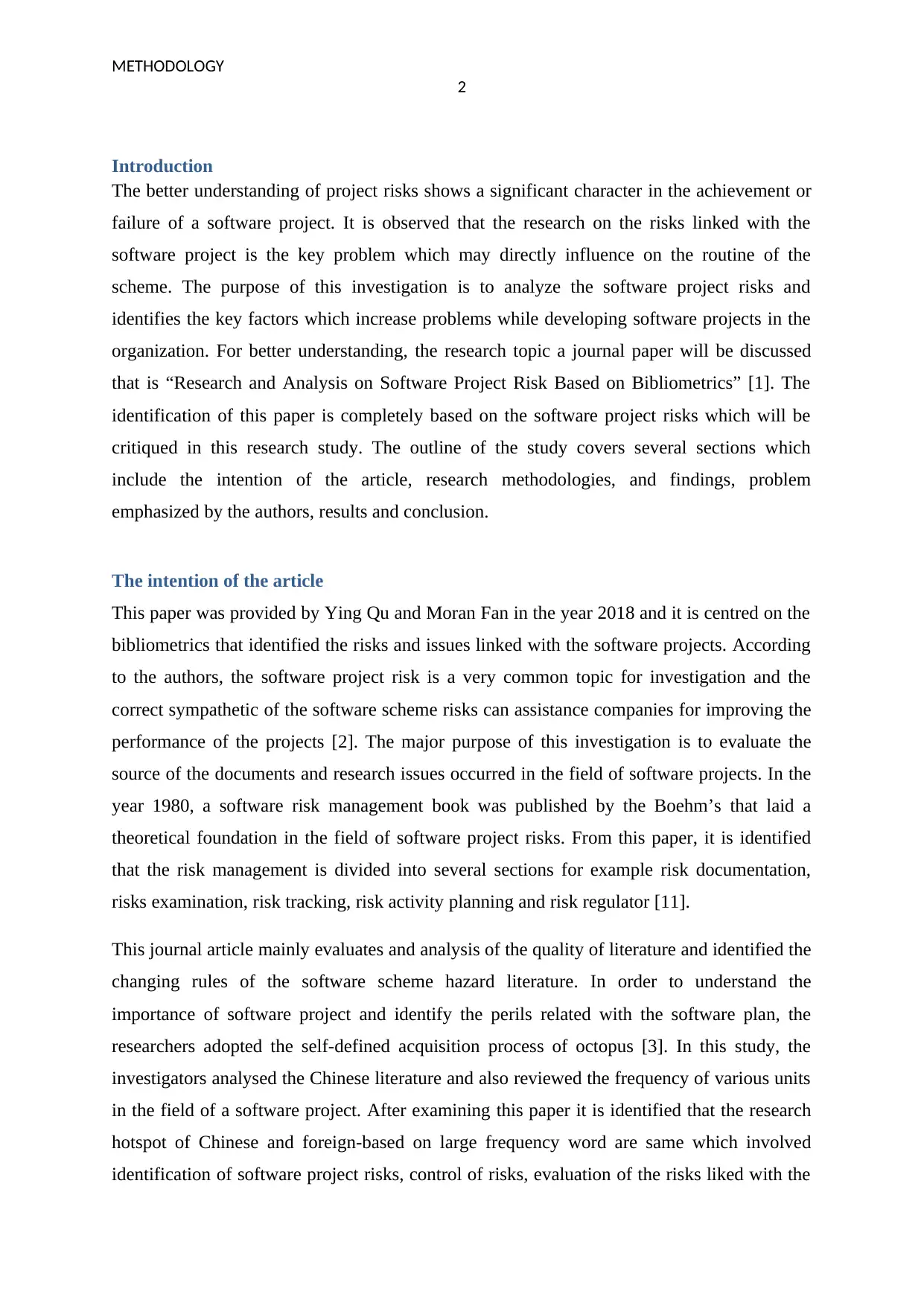
METHODOLOGY
2
Introduction
The better understanding of project risks shows a significant character in the achievement or
failure of a software project. It is observed that the research on the risks linked with the
software project is the key problem which may directly influence on the routine of the
scheme. The purpose of this investigation is to analyze the software project risks and
identifies the key factors which increase problems while developing software projects in the
organization. For better understanding, the research topic a journal paper will be discussed
that is “Research and Analysis on Software Project Risk Based on Bibliometrics” [1]. The
identification of this paper is completely based on the software project risks which will be
critiqued in this research study. The outline of the study covers several sections which
include the intention of the article, research methodologies, and findings, problem
emphasized by the authors, results and conclusion.
The intention of the article
This paper was provided by Ying Qu and Moran Fan in the year 2018 and it is centred on the
bibliometrics that identified the risks and issues linked with the software projects. According
to the authors, the software project risk is a very common topic for investigation and the
correct sympathetic of the software scheme risks can assistance companies for improving the
performance of the projects [2]. The major purpose of this investigation is to evaluate the
source of the documents and research issues occurred in the field of software projects. In the
year 1980, a software risk management book was published by the Boehm’s that laid a
theoretical foundation in the field of software project risks. From this paper, it is identified
that the risk management is divided into several sections for example risk documentation,
risks examination, risk tracking, risk activity planning and risk regulator [11].
This journal article mainly evaluates and analysis of the quality of literature and identified the
changing rules of the software scheme hazard literature. In order to understand the
importance of software project and identify the perils related with the software plan, the
researchers adopted the self-defined acquisition process of octopus [3]. In this study, the
investigators analysed the Chinese literature and also reviewed the frequency of various units
in the field of a software project. After examining this paper it is identified that the research
hotspot of Chinese and foreign-based on large frequency word are same which involved
identification of software project risks, control of risks, evaluation of the risks liked with the
2
Introduction
The better understanding of project risks shows a significant character in the achievement or
failure of a software project. It is observed that the research on the risks linked with the
software project is the key problem which may directly influence on the routine of the
scheme. The purpose of this investigation is to analyze the software project risks and
identifies the key factors which increase problems while developing software projects in the
organization. For better understanding, the research topic a journal paper will be discussed
that is “Research and Analysis on Software Project Risk Based on Bibliometrics” [1]. The
identification of this paper is completely based on the software project risks which will be
critiqued in this research study. The outline of the study covers several sections which
include the intention of the article, research methodologies, and findings, problem
emphasized by the authors, results and conclusion.
The intention of the article
This paper was provided by Ying Qu and Moran Fan in the year 2018 and it is centred on the
bibliometrics that identified the risks and issues linked with the software projects. According
to the authors, the software project risk is a very common topic for investigation and the
correct sympathetic of the software scheme risks can assistance companies for improving the
performance of the projects [2]. The major purpose of this investigation is to evaluate the
source of the documents and research issues occurred in the field of software projects. In the
year 1980, a software risk management book was published by the Boehm’s that laid a
theoretical foundation in the field of software project risks. From this paper, it is identified
that the risk management is divided into several sections for example risk documentation,
risks examination, risk tracking, risk activity planning and risk regulator [11].
This journal article mainly evaluates and analysis of the quality of literature and identified the
changing rules of the software scheme hazard literature. In order to understand the
importance of software project and identify the perils related with the software plan, the
researchers adopted the self-defined acquisition process of octopus [3]. In this study, the
investigators analysed the Chinese literature and also reviewed the frequency of various units
in the field of a software project. After examining this paper it is identified that the research
hotspot of Chinese and foreign-based on large frequency word are same which involved
identification of software project risks, control of risks, evaluation of the risks liked with the
⊘ This is a preview!⊘
Do you want full access?
Subscribe today to unlock all pages.

Trusted by 1+ million students worldwide
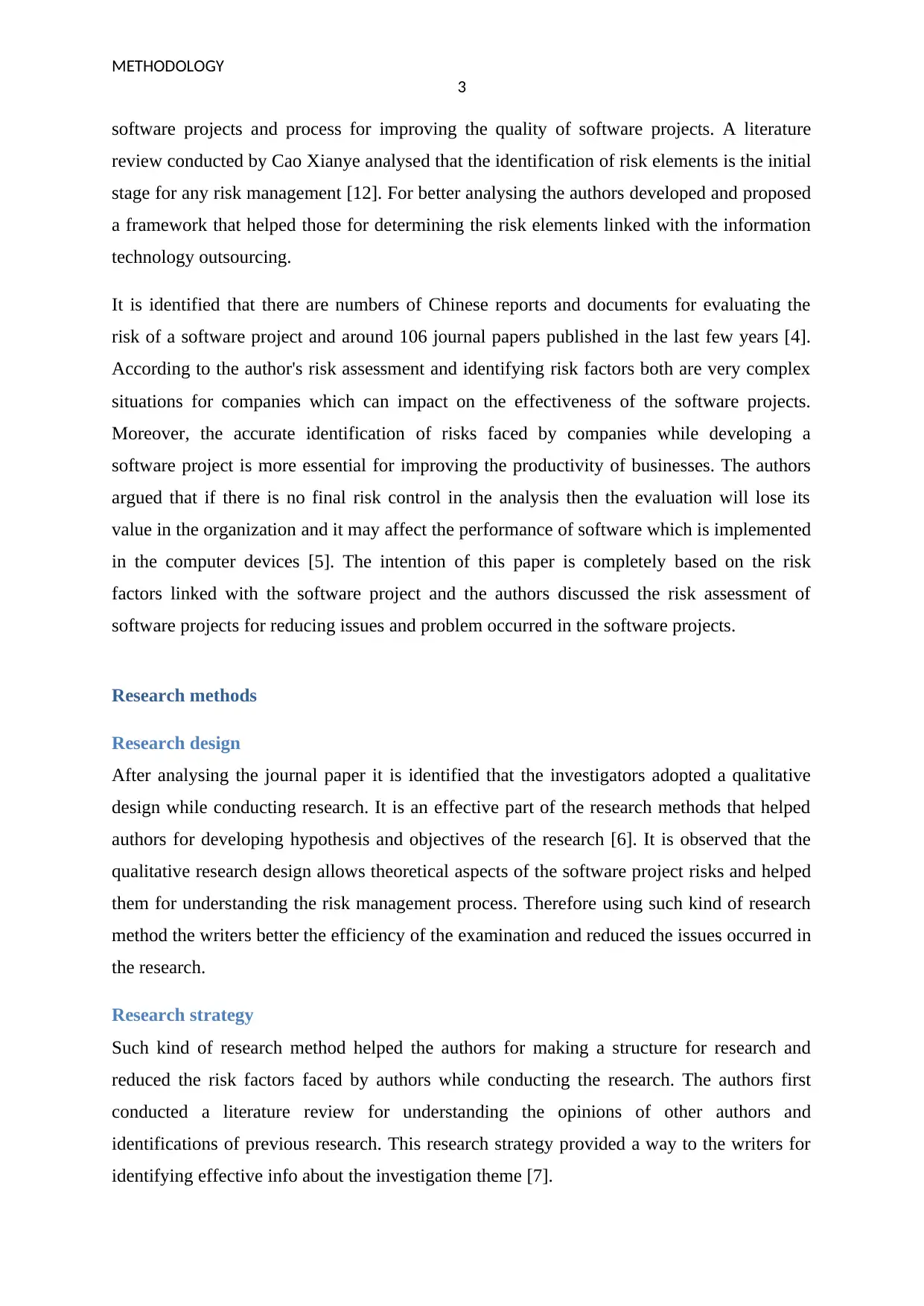
METHODOLOGY
3
software projects and process for improving the quality of software projects. A literature
review conducted by Cao Xianye analysed that the identification of risk elements is the initial
stage for any risk management [12]. For better analysing the authors developed and proposed
a framework that helped those for determining the risk elements linked with the information
technology outsourcing.
It is identified that there are numbers of Chinese reports and documents for evaluating the
risk of a software project and around 106 journal papers published in the last few years [4].
According to the author's risk assessment and identifying risk factors both are very complex
situations for companies which can impact on the effectiveness of the software projects.
Moreover, the accurate identification of risks faced by companies while developing a
software project is more essential for improving the productivity of businesses. The authors
argued that if there is no final risk control in the analysis then the evaluation will lose its
value in the organization and it may affect the performance of software which is implemented
in the computer devices [5]. The intention of this paper is completely based on the risk
factors linked with the software project and the authors discussed the risk assessment of
software projects for reducing issues and problem occurred in the software projects.
Research methods
Research design
After analysing the journal paper it is identified that the investigators adopted a qualitative
design while conducting research. It is an effective part of the research methods that helped
authors for developing hypothesis and objectives of the research [6]. It is observed that the
qualitative research design allows theoretical aspects of the software project risks and helped
them for understanding the risk management process. Therefore using such kind of research
method the writers better the efficiency of the examination and reduced the issues occurred in
the research.
Research strategy
Such kind of research method helped the authors for making a structure for research and
reduced the risk factors faced by authors while conducting the research. The authors first
conducted a literature review for understanding the opinions of other authors and
identifications of previous research. This research strategy provided a way to the writers for
identifying effective info about the investigation theme [7].
3
software projects and process for improving the quality of software projects. A literature
review conducted by Cao Xianye analysed that the identification of risk elements is the initial
stage for any risk management [12]. For better analysing the authors developed and proposed
a framework that helped those for determining the risk elements linked with the information
technology outsourcing.
It is identified that there are numbers of Chinese reports and documents for evaluating the
risk of a software project and around 106 journal papers published in the last few years [4].
According to the author's risk assessment and identifying risk factors both are very complex
situations for companies which can impact on the effectiveness of the software projects.
Moreover, the accurate identification of risks faced by companies while developing a
software project is more essential for improving the productivity of businesses. The authors
argued that if there is no final risk control in the analysis then the evaluation will lose its
value in the organization and it may affect the performance of software which is implemented
in the computer devices [5]. The intention of this paper is completely based on the risk
factors linked with the software project and the authors discussed the risk assessment of
software projects for reducing issues and problem occurred in the software projects.
Research methods
Research design
After analysing the journal paper it is identified that the investigators adopted a qualitative
design while conducting research. It is an effective part of the research methods that helped
authors for developing hypothesis and objectives of the research [6]. It is observed that the
qualitative research design allows theoretical aspects of the software project risks and helped
them for understanding the risk management process. Therefore using such kind of research
method the writers better the efficiency of the examination and reduced the issues occurred in
the research.
Research strategy
Such kind of research method helped the authors for making a structure for research and
reduced the risk factors faced by authors while conducting the research. The authors first
conducted a literature review for understanding the opinions of other authors and
identifications of previous research. This research strategy provided a way to the writers for
identifying effective info about the investigation theme [7].
Paraphrase This Document
Need a fresh take? Get an instant paraphrase of this document with our AI Paraphraser
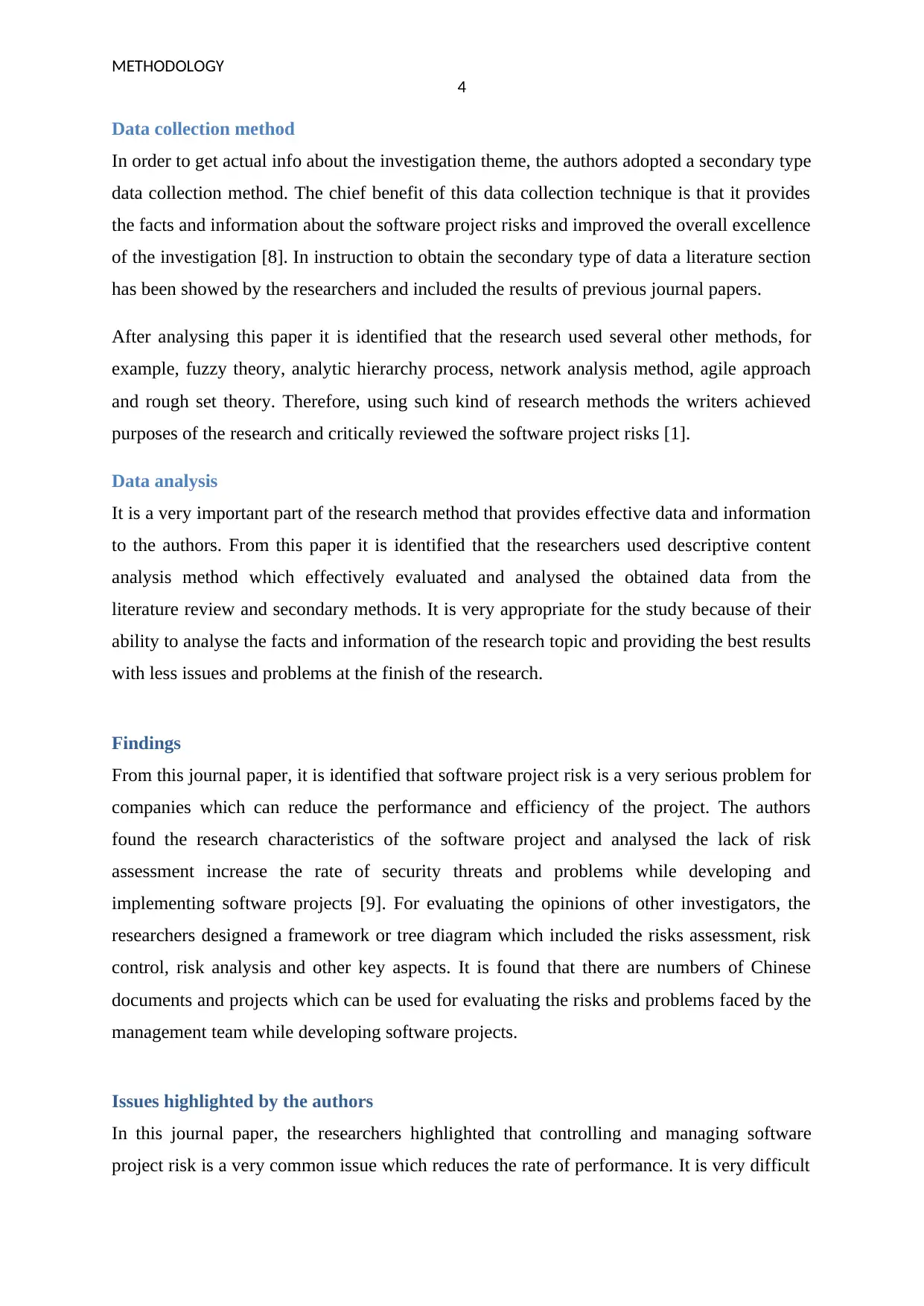
METHODOLOGY
4
Data collection method
In order to get actual info about the investigation theme, the authors adopted a secondary type
data collection method. The chief benefit of this data collection technique is that it provides
the facts and information about the software project risks and improved the overall excellence
of the investigation [8]. In instruction to obtain the secondary type of data a literature section
has been showed by the researchers and included the results of previous journal papers.
After analysing this paper it is identified that the research used several other methods, for
example, fuzzy theory, analytic hierarchy process, network analysis method, agile approach
and rough set theory. Therefore, using such kind of research methods the writers achieved
purposes of the research and critically reviewed the software project risks [1].
Data analysis
It is a very important part of the research method that provides effective data and information
to the authors. From this paper it is identified that the researchers used descriptive content
analysis method which effectively evaluated and analysed the obtained data from the
literature review and secondary methods. It is very appropriate for the study because of their
ability to analyse the facts and information of the research topic and providing the best results
with less issues and problems at the finish of the research.
Findings
From this journal paper, it is identified that software project risk is a very serious problem for
companies which can reduce the performance and efficiency of the project. The authors
found the research characteristics of the software project and analysed the lack of risk
assessment increase the rate of security threats and problems while developing and
implementing software projects [9]. For evaluating the opinions of other investigators, the
researchers designed a framework or tree diagram which included the risks assessment, risk
control, risk analysis and other key aspects. It is found that there are numbers of Chinese
documents and projects which can be used for evaluating the risks and problems faced by the
management team while developing software projects.
Issues highlighted by the authors
In this journal paper, the researchers highlighted that controlling and managing software
project risk is a very common issue which reduces the rate of performance. It is very difficult
4
Data collection method
In order to get actual info about the investigation theme, the authors adopted a secondary type
data collection method. The chief benefit of this data collection technique is that it provides
the facts and information about the software project risks and improved the overall excellence
of the investigation [8]. In instruction to obtain the secondary type of data a literature section
has been showed by the researchers and included the results of previous journal papers.
After analysing this paper it is identified that the research used several other methods, for
example, fuzzy theory, analytic hierarchy process, network analysis method, agile approach
and rough set theory. Therefore, using such kind of research methods the writers achieved
purposes of the research and critically reviewed the software project risks [1].
Data analysis
It is a very important part of the research method that provides effective data and information
to the authors. From this paper it is identified that the researchers used descriptive content
analysis method which effectively evaluated and analysed the obtained data from the
literature review and secondary methods. It is very appropriate for the study because of their
ability to analyse the facts and information of the research topic and providing the best results
with less issues and problems at the finish of the research.
Findings
From this journal paper, it is identified that software project risk is a very serious problem for
companies which can reduce the performance and efficiency of the project. The authors
found the research characteristics of the software project and analysed the lack of risk
assessment increase the rate of security threats and problems while developing and
implementing software projects [9]. For evaluating the opinions of other investigators, the
researchers designed a framework or tree diagram which included the risks assessment, risk
control, risk analysis and other key aspects. It is found that there are numbers of Chinese
documents and projects which can be used for evaluating the risks and problems faced by the
management team while developing software projects.
Issues highlighted by the authors
In this journal paper, the researchers highlighted that controlling and managing software
project risk is a very common issue which reduces the rate of performance. It is very difficult
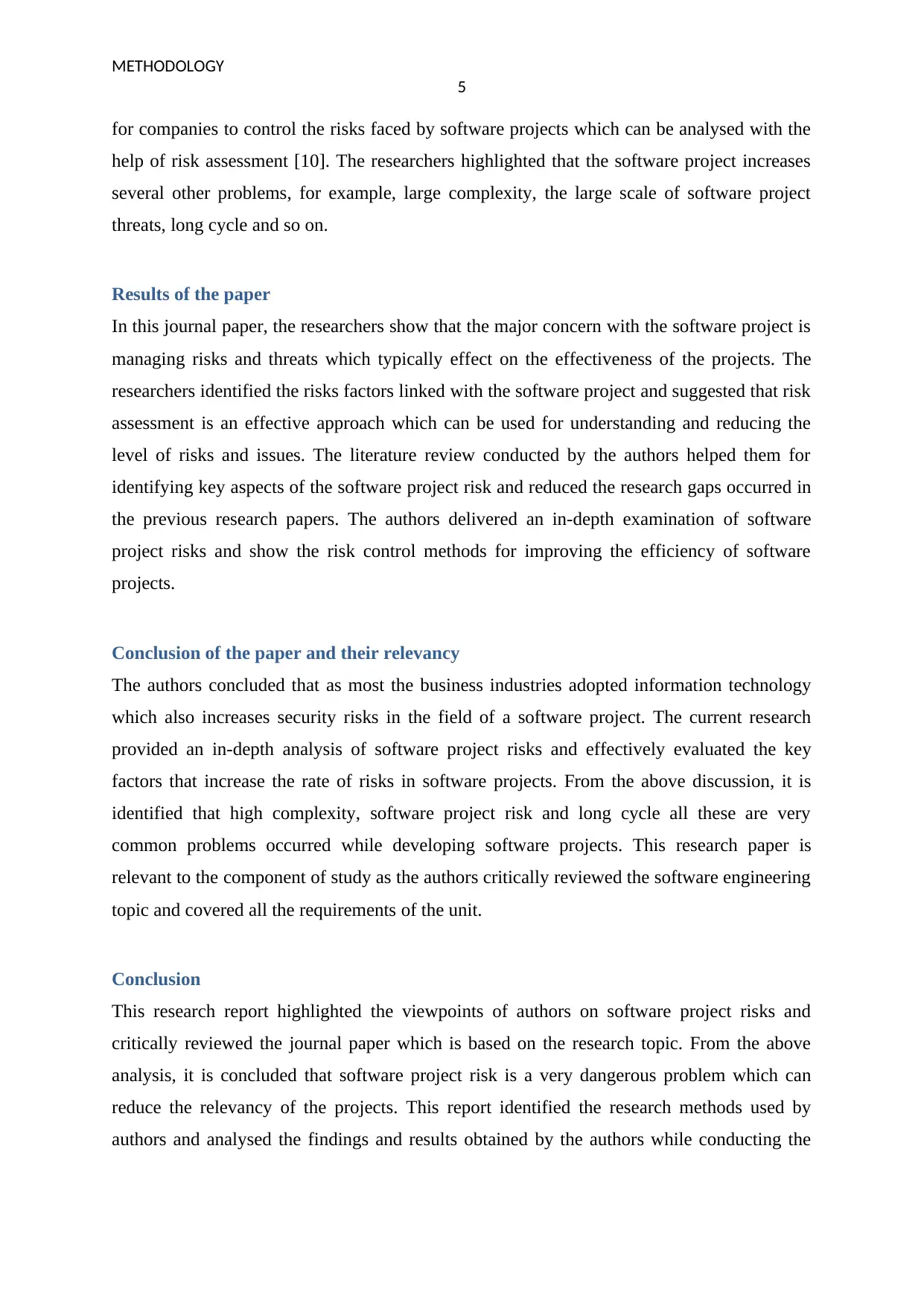
METHODOLOGY
5
for companies to control the risks faced by software projects which can be analysed with the
help of risk assessment [10]. The researchers highlighted that the software project increases
several other problems, for example, large complexity, the large scale of software project
threats, long cycle and so on.
Results of the paper
In this journal paper, the researchers show that the major concern with the software project is
managing risks and threats which typically effect on the effectiveness of the projects. The
researchers identified the risks factors linked with the software project and suggested that risk
assessment is an effective approach which can be used for understanding and reducing the
level of risks and issues. The literature review conducted by the authors helped them for
identifying key aspects of the software project risk and reduced the research gaps occurred in
the previous research papers. The authors delivered an in-depth examination of software
project risks and show the risk control methods for improving the efficiency of software
projects.
Conclusion of the paper and their relevancy
The authors concluded that as most the business industries adopted information technology
which also increases security risks in the field of a software project. The current research
provided an in-depth analysis of software project risks and effectively evaluated the key
factors that increase the rate of risks in software projects. From the above discussion, it is
identified that high complexity, software project risk and long cycle all these are very
common problems occurred while developing software projects. This research paper is
relevant to the component of study as the authors critically reviewed the software engineering
topic and covered all the requirements of the unit.
Conclusion
This research report highlighted the viewpoints of authors on software project risks and
critically reviewed the journal paper which is based on the research topic. From the above
analysis, it is concluded that software project risk is a very dangerous problem which can
reduce the relevancy of the projects. This report identified the research methods used by
authors and analysed the findings and results obtained by the authors while conducting the
5
for companies to control the risks faced by software projects which can be analysed with the
help of risk assessment [10]. The researchers highlighted that the software project increases
several other problems, for example, large complexity, the large scale of software project
threats, long cycle and so on.
Results of the paper
In this journal paper, the researchers show that the major concern with the software project is
managing risks and threats which typically effect on the effectiveness of the projects. The
researchers identified the risks factors linked with the software project and suggested that risk
assessment is an effective approach which can be used for understanding and reducing the
level of risks and issues. The literature review conducted by the authors helped them for
identifying key aspects of the software project risk and reduced the research gaps occurred in
the previous research papers. The authors delivered an in-depth examination of software
project risks and show the risk control methods for improving the efficiency of software
projects.
Conclusion of the paper and their relevancy
The authors concluded that as most the business industries adopted information technology
which also increases security risks in the field of a software project. The current research
provided an in-depth analysis of software project risks and effectively evaluated the key
factors that increase the rate of risks in software projects. From the above discussion, it is
identified that high complexity, software project risk and long cycle all these are very
common problems occurred while developing software projects. This research paper is
relevant to the component of study as the authors critically reviewed the software engineering
topic and covered all the requirements of the unit.
Conclusion
This research report highlighted the viewpoints of authors on software project risks and
critically reviewed the journal paper which is based on the research topic. From the above
analysis, it is concluded that software project risk is a very dangerous problem which can
reduce the relevancy of the projects. This report identified the research methods used by
authors and analysed the findings and results obtained by the authors while conducting the
⊘ This is a preview!⊘
Do you want full access?
Subscribe today to unlock all pages.

Trusted by 1+ million students worldwide

METHODOLOGY
6
research. Therefore, it is suggested that risks assessment is an effective approach that can be
adopted for controlling and managing software project risks.
6
research. Therefore, it is suggested that risks assessment is an effective approach that can be
adopted for controlling and managing software project risks.
Paraphrase This Document
Need a fresh take? Get an instant paraphrase of this document with our AI Paraphraser
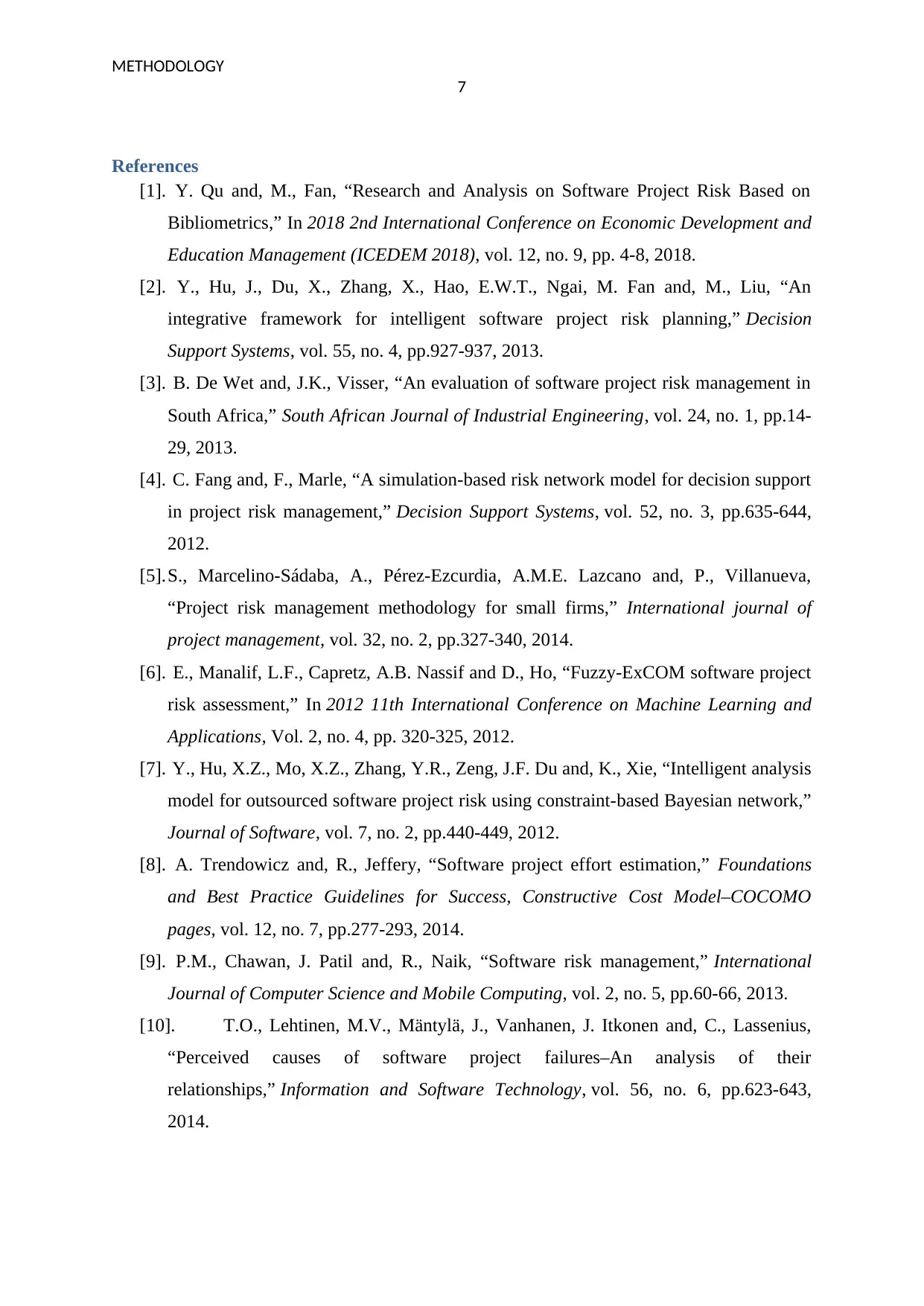
METHODOLOGY
7
References
[1]. Y. Qu and, M., Fan, “Research and Analysis on Software Project Risk Based on
Bibliometrics,” In 2018 2nd International Conference on Economic Development and
Education Management (ICEDEM 2018), vol. 12, no. 9, pp. 4-8, 2018.
[2]. Y., Hu, J., Du, X., Zhang, X., Hao, E.W.T., Ngai, M. Fan and, M., Liu, “An
integrative framework for intelligent software project risk planning,” Decision
Support Systems, vol. 55, no. 4, pp.927-937, 2013.
[3]. B. De Wet and, J.K., Visser, “An evaluation of software project risk management in
South Africa,” South African Journal of Industrial Engineering, vol. 24, no. 1, pp.14-
29, 2013.
[4]. C. Fang and, F., Marle, “A simulation-based risk network model for decision support
in project risk management,” Decision Support Systems, vol. 52, no. 3, pp.635-644,
2012.
[5].S., Marcelino-Sádaba, A., Pérez-Ezcurdia, A.M.E. Lazcano and, P., Villanueva,
“Project risk management methodology for small firms,” International journal of
project management, vol. 32, no. 2, pp.327-340, 2014.
[6]. E., Manalif, L.F., Capretz, A.B. Nassif and D., Ho, “Fuzzy-ExCOM software project
risk assessment,” In 2012 11th International Conference on Machine Learning and
Applications, Vol. 2, no. 4, pp. 320-325, 2012.
[7]. Y., Hu, X.Z., Mo, X.Z., Zhang, Y.R., Zeng, J.F. Du and, K., Xie, “Intelligent analysis
model for outsourced software project risk using constraint-based Bayesian network,”
Journal of Software, vol. 7, no. 2, pp.440-449, 2012.
[8]. A. Trendowicz and, R., Jeffery, “Software project effort estimation,” Foundations
and Best Practice Guidelines for Success, Constructive Cost Model–COCOMO
pages, vol. 12, no. 7, pp.277-293, 2014.
[9]. P.M., Chawan, J. Patil and, R., Naik, “Software risk management,” International
Journal of Computer Science and Mobile Computing, vol. 2, no. 5, pp.60-66, 2013.
[10]. T.O., Lehtinen, M.V., Mäntylä, J., Vanhanen, J. Itkonen and, C., Lassenius,
“Perceived causes of software project failures–An analysis of their
relationships,” Information and Software Technology, vol. 56, no. 6, pp.623-643,
2014.
7
References
[1]. Y. Qu and, M., Fan, “Research and Analysis on Software Project Risk Based on
Bibliometrics,” In 2018 2nd International Conference on Economic Development and
Education Management (ICEDEM 2018), vol. 12, no. 9, pp. 4-8, 2018.
[2]. Y., Hu, J., Du, X., Zhang, X., Hao, E.W.T., Ngai, M. Fan and, M., Liu, “An
integrative framework for intelligent software project risk planning,” Decision
Support Systems, vol. 55, no. 4, pp.927-937, 2013.
[3]. B. De Wet and, J.K., Visser, “An evaluation of software project risk management in
South Africa,” South African Journal of Industrial Engineering, vol. 24, no. 1, pp.14-
29, 2013.
[4]. C. Fang and, F., Marle, “A simulation-based risk network model for decision support
in project risk management,” Decision Support Systems, vol. 52, no. 3, pp.635-644,
2012.
[5].S., Marcelino-Sádaba, A., Pérez-Ezcurdia, A.M.E. Lazcano and, P., Villanueva,
“Project risk management methodology for small firms,” International journal of
project management, vol. 32, no. 2, pp.327-340, 2014.
[6]. E., Manalif, L.F., Capretz, A.B. Nassif and D., Ho, “Fuzzy-ExCOM software project
risk assessment,” In 2012 11th International Conference on Machine Learning and
Applications, Vol. 2, no. 4, pp. 320-325, 2012.
[7]. Y., Hu, X.Z., Mo, X.Z., Zhang, Y.R., Zeng, J.F. Du and, K., Xie, “Intelligent analysis
model for outsourced software project risk using constraint-based Bayesian network,”
Journal of Software, vol. 7, no. 2, pp.440-449, 2012.
[8]. A. Trendowicz and, R., Jeffery, “Software project effort estimation,” Foundations
and Best Practice Guidelines for Success, Constructive Cost Model–COCOMO
pages, vol. 12, no. 7, pp.277-293, 2014.
[9]. P.M., Chawan, J. Patil and, R., Naik, “Software risk management,” International
Journal of Computer Science and Mobile Computing, vol. 2, no. 5, pp.60-66, 2013.
[10]. T.O., Lehtinen, M.V., Mäntylä, J., Vanhanen, J. Itkonen and, C., Lassenius,
“Perceived causes of software project failures–An analysis of their
relationships,” Information and Software Technology, vol. 56, no. 6, pp.623-643,
2014.
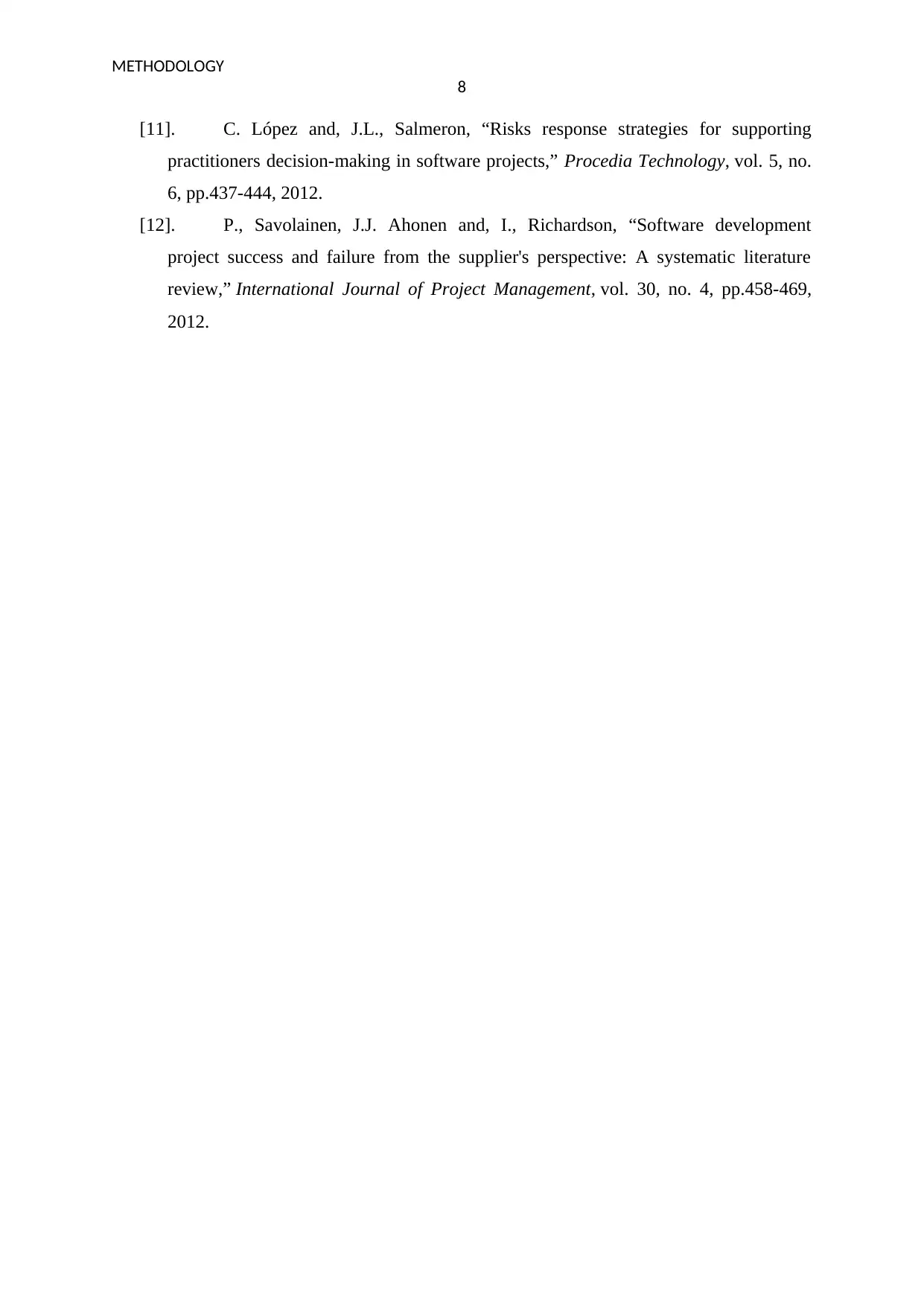
METHODOLOGY
8
[11]. C. López and, J.L., Salmeron, “Risks response strategies for supporting
practitioners decision-making in software projects,” Procedia Technology, vol. 5, no.
6, pp.437-444, 2012.
[12]. P., Savolainen, J.J. Ahonen and, I., Richardson, “Software development
project success and failure from the supplier's perspective: A systematic literature
review,” International Journal of Project Management, vol. 30, no. 4, pp.458-469,
2012.
8
[11]. C. López and, J.L., Salmeron, “Risks response strategies for supporting
practitioners decision-making in software projects,” Procedia Technology, vol. 5, no.
6, pp.437-444, 2012.
[12]. P., Savolainen, J.J. Ahonen and, I., Richardson, “Software development
project success and failure from the supplier's perspective: A systematic literature
review,” International Journal of Project Management, vol. 30, no. 4, pp.458-469,
2012.
⊘ This is a preview!⊘
Do you want full access?
Subscribe today to unlock all pages.

Trusted by 1+ million students worldwide
1 out of 9
Related Documents
Your All-in-One AI-Powered Toolkit for Academic Success.
+13062052269
info@desklib.com
Available 24*7 on WhatsApp / Email
![[object Object]](/_next/static/media/star-bottom.7253800d.svg)
Unlock your academic potential
Copyright © 2020–2025 A2Z Services. All Rights Reserved. Developed and managed by ZUCOL.





